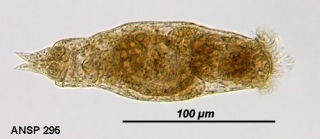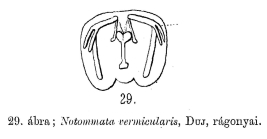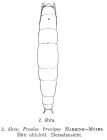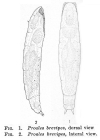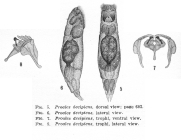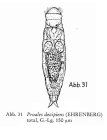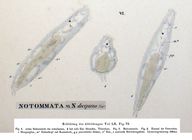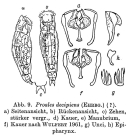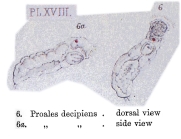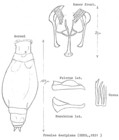RAS taxon details
Proales Gosse, 1886
134953 (urn:lsid:marinespecies.org:taxname:134953)
accepted
Genus
- Species Proales daphnicola Thompson, 1892
- Species Proales fallaciosa Wulfert, 1937
- Species Proales halophila Remane, 1929
- Species Proales minima (Montet, 1915)
- Species Proales reinhardti (Ehrenberg, 1834)
marine, brackish, fresh, terrestrial
recent only
feminine
Hudson, C. T.; Gosse, P. H. (1886). The Rotifera; or wheel-animalcules, both British and foreign. London. Longmans, Green, and Co., I+II, 2, VI+128, pl.1-15; 144, pl.A-D,16-30, available online at https://www.biodiversitylibrary.org/page/10664748
page(s): v.2, p.36 [details] Available for editors
page(s): v.2, p.36 [details] Available for editors
Jersabek, C. D.; Segers H.; Leitner M. (2025). Rotifera World Catalog (RWC). Proales Gosse, 1886. Accessed through: RAS (Eds.) (2025) Register of Antarctic Species at: https://ras.biodiversity.aq/aphia.php/www.pfeil-verlag.de/04biol/aphia.php?p=taxdetails&id=134953 on 2025-09-12
RAS (Eds.) (2025). Register of Antarctic Species. Proales Gosse, 1886. Accessed at: https://ras.biodiversity.aq/aphia.php/www.pfeil-verlag.de/04biol/www.pfeil-verlag.de/04biol/aphia.php?p=taxdetails&id=134953 on 2025-09-12
Date
action
by
2004-12-21 15:54:05Z
created
db_admin
2006-09-27 07:06:07Z
changed
Martinez, Olga
original description
Hudson, C. T.; Gosse, P. H. (1886). The Rotifera; or wheel-animalcules, both British and foreign. London. Longmans, Green, and Co., I+II, 2, VI+128, pl.1-15; 144, pl.A-D,16-30, available online at https://www.biodiversitylibrary.org/page/10664748
page(s): v.2, p.36 [details] Available for editors
taxonomy source De Smet, W. H. (1996). Rotifera. Volume 4: The Proalidae (Monogononta). In: T. Nogrady. Guides to the identification of the microinvertebrates of the continental waters of the world. Amsterdam. SPB Academic Publishing, 9, 102 [details] Available for editors
basis of record O'Reilly, M. (2001). Rotifera, <B><I>in</I></B>: Costello, M.J. <i>et al.</i> (Ed.) (2001). <i>European register of marine species: a check-list of the marine species in Europe and a bibliography of guides to their identification. Collection Patrimoines Naturels,</i> 50: pp. 149-151 (look up in IMIS) [details]
additional source Brunel, P., L. Bosse & G. Lamarche. (1998). Catalogue of the marine invertebrates of the estuary and Gulf of St. Lawrence. <em>Canadian Special Publication of Fisheries and Aquatic Sciences, 126.</em> 405 pp. (look up in IMIS) [details] Available for editors
additional source Neave, Sheffield Airey. (1939-1996). Nomenclator Zoologicus vol. 1-10 Online. <em>[Online Nomenclator Zoologicus at Checklistbank. Ubio link has gone].</em> , available online at https://www.checklistbank.org/dataset/126539/about
page(s): a [details]
additional source Shiel, R.; Smales, L.; Sterrer, W.; Duggan, I.C.; Pichelin, S.; Green, J.D. (2009). Phylum Gnathifera: lesser jaw worms, rotifers, thorny-headed worms, in: Gordon, D.P. (Ed.) (2009). New Zealand inventory of biodiversity: 1. Kingdom Animalia: Radiata, Lophotrochozoa, Deuterostomia. pp. 137-158. [details]
additional source Integrated Taxonomic Information System (ITIS). , available online at http://www.itis.gov [details]
page(s): v.2, p.36 [details] Available for editors
taxonomy source De Smet, W. H. (1996). Rotifera. Volume 4: The Proalidae (Monogononta). In: T. Nogrady. Guides to the identification of the microinvertebrates of the continental waters of the world. Amsterdam. SPB Academic Publishing, 9, 102 [details] Available for editors
basis of record O'Reilly, M. (2001). Rotifera, <B><I>in</I></B>: Costello, M.J. <i>et al.</i> (Ed.) (2001). <i>European register of marine species: a check-list of the marine species in Europe and a bibliography of guides to their identification. Collection Patrimoines Naturels,</i> 50: pp. 149-151 (look up in IMIS) [details]
additional source Brunel, P., L. Bosse & G. Lamarche. (1998). Catalogue of the marine invertebrates of the estuary and Gulf of St. Lawrence. <em>Canadian Special Publication of Fisheries and Aquatic Sciences, 126.</em> 405 pp. (look up in IMIS) [details] Available for editors
additional source Neave, Sheffield Airey. (1939-1996). Nomenclator Zoologicus vol. 1-10 Online. <em>[Online Nomenclator Zoologicus at Checklistbank. Ubio link has gone].</em> , available online at https://www.checklistbank.org/dataset/126539/about
page(s): a [details]
additional source Shiel, R.; Smales, L.; Sterrer, W.; Duggan, I.C.; Pichelin, S.; Green, J.D. (2009). Phylum Gnathifera: lesser jaw worms, rotifers, thorny-headed worms, in: Gordon, D.P. (Ed.) (2009). New Zealand inventory of biodiversity: 1. Kingdom Animalia: Radiata, Lophotrochozoa, Deuterostomia. pp. 137-158. [details]
additional source Integrated Taxonomic Information System (ITIS). , available online at http://www.itis.gov [details]
From editor or global species database
